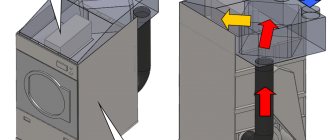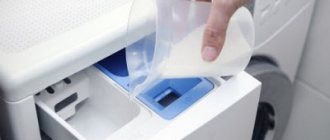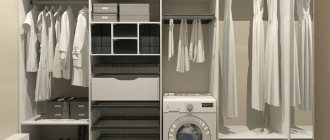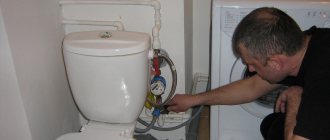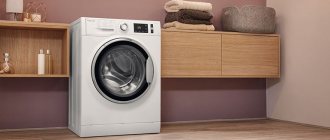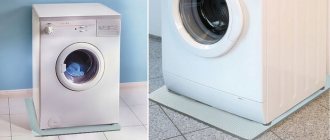When planning the design of any room, you want to combine convenience and aesthetics. It is especially difficult to do this in the bathroom, because there are especially many household appliances, appliances and other items that are not the most aesthetically pleasing. One of these is a washing machine in the bathroom. Many people want to hide not only the communications adjacent to it, but also the unit itself.
There are many options for completely or partially disguising a washing machine in the bathroom interior
How to properly hide a washing machine in the bathroom
Many people ask the question of how to hide a washing machine in the bathroom. Fortunately, there are several options on how to do this. There are radical solutions, for example, the construction of special structures, the manufacture of cabinets for equipment and laundry baskets, and there are also less expensive options.
One of the simplest solutions is to slide the machine under the tabletop and close it with a curtain. The tabletop can be made folding if access to the top panel of the unit is required
Curtains must be selected so that they fit into the interior of the room
This article will look at the most popular ways to properly hide a washing machine in the bathroom. Each room has its own nuances. One of the significant ones is the size of the room. The methods for placing a washing machine in a small bathroom differ from those for medium or large rooms.
A completely hidden washing machine maintains the basic line of bathroom design
Using a curtain
A simple and affordable way to disguise a washing machine is to use a decorative curtain, behind which you can hide both the unit itself and the plumbing lines. The curtain is chosen to match the tone of the wall tiles - variegated or plain, depending on the pattern on the tile.
It is better to choose curtains made of vinyl or textiles impregnated with a hydrophobic composition. They are more durable and have dirt-repellent properties. The curtain is hung on hooks or eyelets, installed on a straight or circular rod.
Options to hide a washing machine in a bathroom of different sizes
When installing a washing machine, especially if you need to place it as discreetly as possible, you need to take into account the size of the bathroom.
In a small bathroom
If the room is not large in size and is also quite narrow, then it is advisable to take this into account at the purchase stage and choose small-sized front-loading units. Such models hold no more than 4.5 kg when loaded. If this indicator is not satisfactory, and a larger capacity is needed, then you can choose models with vertical loading.
The most compact option for placing the machine is right under the washbasin.
Such a tandem should be selected in pairs - there are both special sinks and narrower and lower washing machines on sale
A full-size washing machine can be placed in the bathroom if you save space by installing a smaller bathtub or shower.
Replacing a bath with a shower will allow you to install a washing machine and place something useful above it - a cabinet, shelves or a heated towel rail
If you don’t want to sacrifice either the full size of the unit or the size of the bathtub, then you can increase the area of the room by combining it with a toilet or borrowing the area of the corridor.
Another solution is a compact wall-mounted washing machine model
In the average bathroom
In a medium-sized space you can comfortably place everything you need (without frills, of course), however, it is still important to take into account some important nuances. For example, the width of a doorway. As a rule, in medium-sized baths their width is only 60 cm. This means that only a machine with a depth of no more than 55 cm can be installed in such a room. Models with a depth of 60 or 65 cm can only be installed if the opening is first widened.
The washing machine can be placed under a common countertop next to the sink
There must be a gap between the machine and the tabletop so that vibration does not have a destructive effect.
You need to add a couple of centimeters to the depth of the unit, which are added from behind the hatch door.
In a large bathroom
The spacious room frees the apartment owners from thinking about where to fit all the necessary equipment, since in such a bathroom there is enough space for everything. All that remains is to use your imagination to choose the most suitable and convenient place. When choosing a location, you need to consider the location of outlets and water pipes.
If there is furniture in a spacious bathroom, it is better to place the machine inside a cabinet or in a niche with shelves
The dimensions of the cabinet depend on the dimensions of the machine and the availability of free space in the bathroom
If possible, it is advisable to install the equipment at some distance from the bathtub to prevent water from getting on the equipment.
If this is not possible, then you can install a partition that will protect the equipment from moisture.
Choosing the right plumbing fixtures and appliances
Pay attention to the manufacturer's quality guarantee - this is an important point for a quality product. For medium-sized and small-sized bathrooms, it is better to choose small-sized (for example, wall-mounted) models of toilets and sinks.
For a bathroom with cramped space, a rational solution would be to install a small corner sink.
Which bath to choose
When deciding on the size of the product, consider the material of manufacture. There are three common options:
- Steel is a cheap and lightweight material; it heats up and cools down instantly, which is not very convenient for lovers of water treatments.
- Cast iron: withstands heat for a long time, heavy and durable material. But there is also a downside: mechanical shock causes chips.
- Acrylic is a modern high-quality material, durable and not heavy. Requires special care: the surface is easy to scratch.
Be sure to consider these points when shopping to ensure your bathroom is comfortable.
A full bathroom is usually located along the longest wall
Corner models are more compact and save space for a washing machine or piece of furniture
Examples of placement for hiding a washing machine in the bathroom (photo)
In most cases, owners have a desire to hide or disguise household appliances so that they do not violate the aesthetics of the space design. This can be done in different ways. Let's look at the most common ones.
Washing machine cabinet with washbasin and pull-out basket
A cabinet with a pull-out section containing convenient plastic containers for laundry
Hide in a box
You can hide equipment in the bathroom in a specially prepared box or cabinet. It can be made from MDF boards, natural wood, which must be treated with a water-repellent agent, as well as glass or plastic. Before you begin installation, you need to take measurements of the equipment so that it fits in the box and leaves the necessary space for communications. This option is very convenient, since you can think through special niches in the box in advance. They are useful for storing laundry before washing and organizing household products.
Placing the machine inside a cabinet with doors will make the appearance of the bathroom more aesthetically pleasing and protect the device from unnecessary splashes.
It is best to make such furniture to order, taking into account the size and features of the bathroom.
Built into the countertop
The machine can be built into the countertop either with or without a door. Installation without a door will be much easier: just prepare an empty niche for installation and select a machine of the appropriate height for the countertop. In this case, the equipment will be visible, which means its appearance should always be impeccable.
It will be ideal if you can choose a washing machine model to match the bathroom interior
The second option - a countertop with a door, will allow you to hide both the machine itself and all the accompanying attributes - a laundry basket (if there is space for it), household chemicals, and so on. However, it will be important to choose a model of suitable length if the appliances under the countertop will be part of a solid furniture set.
The door can be hinged - in this case it is important that there is free space for it to open completely
The sliding door allows you to place the unit in more cramped spaces
A machine in a cabinet with doors that crack like a book
There are models of washing machines with integrated doors
Types of shells
These ceramic products are distinguished by their diversity. They can be divided according to the following characteristics:
- dimensions;
- bowl shape;
- material;
- drain location;
- fastening method;
- presence of a tabletop.
Dimensions
Most water lilies are rectangular in shape. The width and depth are mainly tied to the standard dimensions of the washing machine table. The height of the ceramics is approximately the same, 89 – 100 mm, although there are exceptions. The frontal dimension is usually 600 mm, while the depth can be 600, 500 and 480 mm.
Bowl shape
Water lilies come in rectangular, oval and designer varieties. The inner surface of the bowl can be of a standard form, that is, in the form of an inverted dome.
There are bowls with an inner surface in the form of an inclined platform - a ramp, when the drain is not a round hole, but a horizontal slot.
Material
The leading place in this regard is occupied by faience and porcelain. In mass production, ceramic bowls are made from earthenware; they are cheaper than their porcelain counterparts. Both have a beautiful appearance, are easy to clean and are almost silent when a stream of water falls from the tap. The characteristics of both materials should be taken into account - they are fragile and heavy.
Article on the topic: How to open an indesit witl 1067 washing machine
Along with these materials, bowls are made from natural stone such as granite. So far, water lilies made from this material are not found on the plumbing market. The same can be said about artificial stone. But as cut-in devices, they can be used quite well. Glass models are interesting. Glass bowls are beautiful and hygienic.
A budget option is acrylic devices. Their disadvantage is the rapid loss of beautiful appearance due to high adhesion to various contaminants.
Designer models are made from a variety of materials, but due to the high price, it is not practical to use ceramics of this type as a “roof” over the washing machine.
Drain location
The location of the drain hole determines the gap between the sink and the countertop of the washing machine. If the drain is located in the center of the bowl, then the drain from below will protrude greatly and the gap may be about 150 mm. From the outside it will not look very aesthetically pleasing.
To minimize the gap between two appliances, manufacturers began to place the drain hole in one of the corners of the ceramic product or in its center at the back to the wall. This made it possible not only to remove the siphon from the electrical unit, but also to protect it in the event of a water spill.
Mounting method
Manufacturers of water lilies offer three methods of fastening:
- installing the bowl on brackets;
- fastening with dowels through technological holes in the lower part of the back wall of the sink;
- insertion of the vessel into the tabletop.
Brackets
Manufacturers supply a mounting kit with the sink - two brackets with dowels and washers. The supports consist of two bent profiles in the form of elongated triangles with curved edges. There are holes for dowels on the end bends, and longitudinal grooves on the elongated part.
Anchor bolts
There are models that are attached to the wall with anchor bolts. For this purpose, two technological holes are made in the ebb of the back wall of the bowl. The ceramics in this place are reinforced by the thickness of the array.
Article on the topic: How much does it cost to change a bearing in an Indesit washing machine
Bowl insert
There are options when a countertop is installed above the washing machine. A landing opening is cut out in it, where the bowl is inserted. In this way, it is ensured that the sink does not hang over the unit, but is located to the side along with the water supply and drain fittings.
Some designers suggest embedding the sink into the countertop directly above the washing machine. But this option is quite complicated due to the cramped location of communications in the hidden space behind the unit and is practically not used.
How to cover a washing machine in the bathroom
If the washing machine stands “by itself” and is not covered by either the surface of the niche or the countertop, it can be covered in another way. One of the most common is oilcloth. It does not allow moisture to pass onto the surface of the equipment and protects it from mechanical damage, scratches and dust. Textile napkins can perform the same function - both from natural dense fabrics and synthetics.
To prevent the machine from being scratched, the cape should be thick and dense enough
It is convenient to use a specially made cover with an elastic band
How to properly hide hoses from a washing machine in the bathroom
The correct location of all relevant communications is very important, since the proper operation of the technical unit depends on it. The hoses must not be twisted or pressed against anything. In addition to serviceability, the visual component is also important. Protruding hoses, which also take up valuable free space, will not fit into any interior. To properly hide communications, you need to pay attention to some nuances during installation. Ideally, 10 cm should be left between the back wall of the machine and the wall of the room. This is necessary so that the hoses do not cling to the existing protrusions.
Placing hoses from the washing machine in the washbasin box
An excellent location option would be to install the machine with the side wall towards the bathtub and the back against the wall. This will allow you to route the drain hose and water supply hose under the bathtub. For a more aesthetic appearance, the end of the bathtub can be decorated with a special partition made of plastic or plasterboard. All the hoses will be hidden behind it, and the free space can be used to store household chemicals.
Placing hoses under the bathtub behind the decorative panel
These are just general recommendations that will allow you to competently approach the process of installation and location of hoses. Each specific case can be completely individual, so it is better to seek advice from a specialist, and he will give specific recommendations, taking into account the size of the room and equipment.
